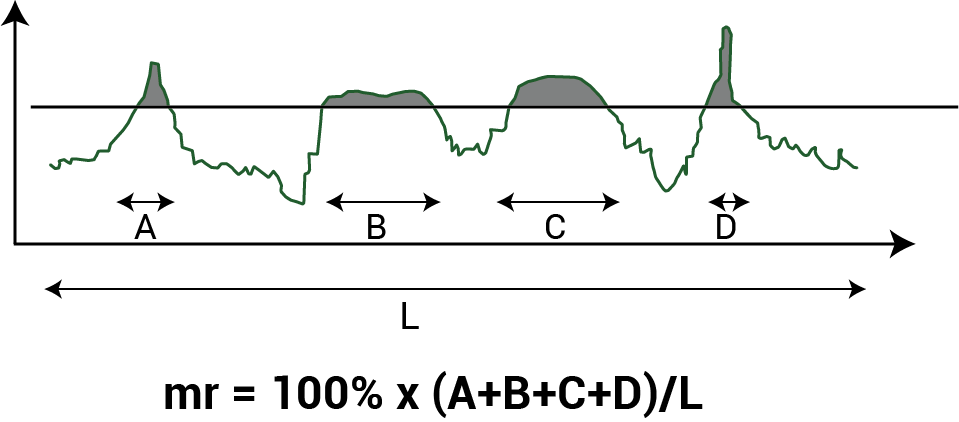Material Ratio - Bearing Area
2D Bearing Area Curve Parameters
The Rk parameters (Rk, Rpk and Rvk) are derived from the Bearing Area Curve based on the ISO 13565-2:1996 standard.
The Bearing Area Curve (also called the Bearing Ratio Curve, or the Abbott-Firestone curve) is plotted by passing a line progressively downward through the surface, from highest peak to deepest valley. The curve gives the ratio of material in the profile at any given depth, compared to a perfectly flat and smooth profile.
For each profile, a bearing area curve is generated by simulating a horizontal line moving through the profile from the top down, evaluating the percentage of contact the line would make with the surface at each level.
The Material Ratio (mr) is that ratio of material in the profile to a perfectly flat and smooth profile, at a given height above the mean plane.

Bearing area curves are helpful in understanding the real contact area of mating surfaces and the change to that contact area as mechanical parts wear (e.g., Rpk). It is also useful in determining lubricant retention for engine components, ink retention for printing applications, etc (e.g., Rvk).
Rpk, or Stylus (X,Y) Rpk, the Reduced Peak Height Along (X,Y), is a measure of the peak height above the core roughness.
Rvk, or Stylus (X,Y) Rvk, the Reduced Valley Depths Along (X, Y), is found from a measure of the valley depths below the core roughness.
Rk, Stylus (X, Y) Rk, the Core Roughness Along (X, Y), is a measure of the core (peak to valley) roughness of the surface with the major peaks and valleys established by Stylus (X, Y) Rpk and Stylus (X, Y) Rvk removed.

Note that each profile in the X and Y directions are evaluated individually and the resulting average is reported.
Application
A high Stylus (X, Y) Rpk implies a surface composed of high peaks providing small initial contact area and thus high areas of contact stress when the surface is contacted. Stylus (X, Y) Rpk may represent the nominal height of the material that may be removed during a running-in operation. Stylus (X, Y) Rvk is a measure of the valley depths below the core roughness and may be related to lubricant retention and debris entrapment. By comparing the various parameters along the different directions (X vs. Y) one may also assess the uniformity of the surface peak and valley distributions relative to a particular direction of interest. Stylus (X, Y) Rk is a measure of the nominal roughness (peak to valley) and may be used to replace parameters such as Stylus (X, Y) Ra, Stylus (X, Y) Rt, or Stylus (X, Y) Rz when anomalous peaks or valleys may adversely affect the repeatability of these parameters.
3D (Areal) Material Ratio Curve Parameters
For 3D (Areal) surface texture, the parameters Spk, Sk, Svk, SMr1, and SMr2 are all derived from the Areal Material Ratio curve, based on the ISO 13565-2:1996 standard.
Spk, the Reduced Peak Height, is a measure of the peak height above the core roughness.
Sk, the Core Roughness Depth, is a measure of the “core” roughness (peak-to-valley) of the surface with the predominant peaks and valleys removed.
Svk, the Reduced Valley Depth, is a measure of the valley depth below the core roughness.
SMr1, the Peak Material Portion, indicates the percentage of material that comprises the peak structures associated with Spk
SMr2, the Valley Material Portion, relates to the percentage (i.e., 100%-SMr2) of the measurement area that comprises the deeper valley structures associated with Svk.

Application
A large Spk implies a surface composed of high peaks providing small initial contact area and thus high areas of contact stress (force/area) when the surface is contacted. Thus Spk may represent the nominal height of the material that may be removed during a running-in operation. Consistent with Spk, SMr1 represents the percentage of the surface that may be removed during running-in. Sk represents the core roughness of the surface over which a load may be distributed after the surface has been run-in. Svk is a measure of the valley depths below the core roughness and may be related to lubricant retention and debris entrapment. Sk is a measure of the nominal roughness (peak to valley) and may be used to replace parameters such as Sz when anomalous peaks or valleys may adversely affect the measurement.
